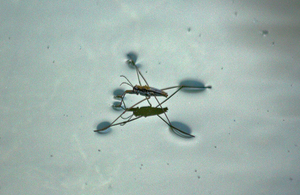Status review of some of Britain’s smallest ‘countryside heroes’ published
Reviews of the conservation status of Britain's centipedes, woodlice, aquatic insects and similar species have been published by Natural England.

Pond skater © Nathan Goddard from Flickr and used under Creative Commons
The most up to date reviews of the conservation status of some of Britain’s smallest but most ecologically important animals have been published by Natural England.
A review of the Diplopoda, Chilopoda and Isopoda of Great Britain assesses the conservation status of centipedes, millipedes and woodlice and identifies the species that are considered to be ‘vulnerable’, ‘endangered’ or ‘critically endangered’.
Despite their small size, millipedes and woodlice are the heroes of the British countryside, and especially our woodlands, where they provide an essential ecosystem service in helping with the decomposition of plant material.
A review of the Hemiptera of Great Britain: The Aquatic and Semi-Aquatic Bugs covers a group of animals that include most children’s favourite pond dwellers; the pond skaters and water boatmen. There are 93 species covered in the new review nearly all of which are either aquatic or are found in damp habitats usually close to water. These animals occur in a wide range of habitats in Britain - from the ditches of Sussex to river banks in the Cairngorms.
Much of the data used to produce these latest reviews has been provided by a network of volunteer observers along with records from conservation and environmental organisations.
Natural England project manager, Jon Webb, said:
These small animals are often overlooked but they have evolved to fill an important ecological function that we take for granted. They are fundamental parts of the food web that supports other life and are also excellent indicators of the health of our natural habitats.
They are also important in their own right, being fascinating creatures with a biology and ecology alien to us. We need to be their custodians and endure that they are not lost on our watch. Natural England supports the production of this kind of review which helps disseminate a wide range of datasets that help to increase understanding of biodiversity and can lead to further research and innovation.
Both groups of minibeasts are highly sensitive to their environment and are regarded as excellent indicators of the health of the natural environment.
Paul Lee, Research Co-ordinator of Hymettus, who undertook the review, said:
This is the first time we have had a comprehensive assessment of the importance of these often overlooked groups and is testament to the vital contribution the volunteer recorders of the British Myriapod and Isopod Group make to nature conservation in Britain.
Both reviews include detailed data sheets for threatened species to help focus resources on managing habitats in the best way and to improve the conservation status of these overlooked but important animals.
The 2 reports are the latest in a series to be published under the species status project, which will help conservation organisations to target future action. The project is a new initiative that provides up-to-date assessments of the threat status of various species of insects using the internationally accepted guidelines developed by the International Union for Conservation of Nature.
Background information
The species status project continues the work of the species status assessment project - initiated by the Joint Nature Conservation Committee in 1999 - which ended in 2008 after producing 15 reports. It seeks to continue the assessment of species in the UK to provide an up-to-date threat status of taxa or families, against standard criteria based on the internationally accepted guidelines developed by the International Union for Conservation of Nature. Natural England is hoping that within 5 years, over 20,000 insect species will be reviewed as part of the assessment project’s work. The species status project is overseen by an inter-agency working group, including staff from Natural England, Joint Nature Conservation Committee and Natural Resources Wales.
For more information about England’s red list species and action being undertaken to ensure their survival, find out about Natural England’s research and the Species Recovery Programme.